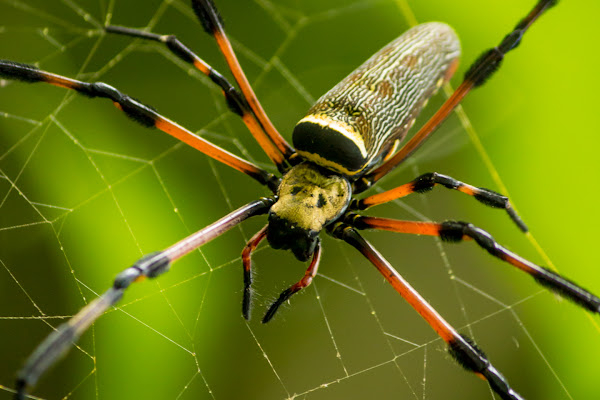Golden Silk Spider
A type of orb-weaving spider found in woodlands and wooded areas from the southern US to Argentina is the Golden Silk Spider (Trichonephila clavipes). In actuality, it is the sole member of the genus Trichonephila that is native to both North and South America's continents. T. clavipes weaves large, asymmetrical circular webs fastened to trees and low shrubs in wooded areas to catch small- and medium-sized flying prey, primarily insects.
The species exhibits strong sexual dimorphism in both size and color pattern, like the majority of orb-weavers. Female T. clavipes spiders can grow from 24 mm to 40 mm in length when completely developed, making them some of the biggest non-tarantula spiders in North America. They might even be the biggest species of native orb weaver in the United States. Additionally, females have very distinctive coloring, which makes the species rather simple to identify. They have a longer orange-brown abdomen with two rows of tiny white-yellow dots and a cephalothorax that is silvery white. As the spider ages, the color of its abdomen changes. The first, second, and fourth leg pairs also have black brush-like hair tufts close to the joints, and their legs are banded with dark yellow and brown coloration.
The Golden Silk Spider, often called the Banana Spider or Writing Spider, is distinguished for its size and silk. This spider's golden silk is stronger and more durable than other spiders'. Golden silk can make big, strong webs that can catch bees, wasps, and even tiny birds. Researchers are exploring commercial and industrial uses for silk's unique qualities.
The Golden Silk Spider's mating is interesting and complex. When a male approaches a female's web for mating, he methodically plucks the silk strands, generating a rhythmic pattern that calms the female and reduces her likelihood of attacking him. "Web plucking" is essential for mating Golden Silk Spiders, who can be hostile and cannibalistic if not courted. To stay safe and mate successfully, the male must approach carefully.
The Golden Silk Spider's size, color patterns, and silk production make it fascinating to study in its wooded habitat across the Americas. Its unique contributions to the world of arachnids and the potential practical uses of its silk underscore the necessity of protecting and appreciating spider diversity in nature.













